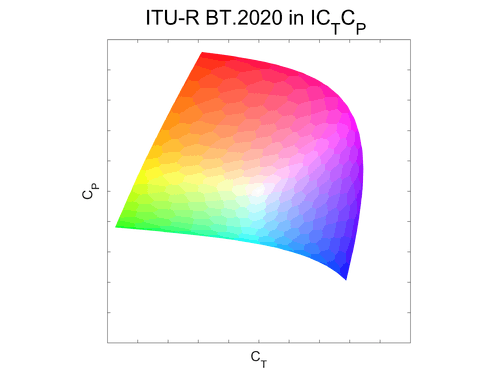ICtCp
ICTCP, ICtCp, or ITP is a color representation format specified in the Rec. ITU-R BT.2100 standard that is used as a part of the color image pipeline in video and digital photography systems for high dynamic range (HDR) and wide color gamut (WCG) imagery.[1] It was developed by Dolby Laboratories. The format is derived from an associated RGB color space by a coordinate transformation that includes two matrix transformations and an intermediate nonlinear transfer function that is informally known as gamma pre-correction. The transformation produces three signals called I, CT, and CP. The ICTCP transformation can be used with RGB signals derived from either the perceptual quantizer (PQ) or hybrid log-gamma (HLG) nonlinearity functions, but is most commonly associated with the PQ function (which was also developed by Dolby).
The I ("intensity") component is a luma component that represents the brightness of the video, and CT and CP are blue-yellow (named from tritanopia) and red-green (named from protanopia) chroma components.[2]
The ICTCP color representation scheme is conceptually related to the LMS color space, as the color transformation from RGB to ICTCP is defined by first converting RGB to LMS with a 3×3 matrix transformation, then applying the nonlinearity function, and then converting the nonlinear signals to ICTCP using another 3×3 matrix transformation.[3]

Derivation
ICTCP is defined by Rec. 2100 as being derived from RGB as follows:[1]
Calculate LMS from BT.2100 RGB:
If the PQ transfer function is used, calculate L′M′S′ using the PQ inverse electro-optical transfer function:
If the HLG transfer function is used, calculate L′M′S′ using the HLG opto-electronic transfer function:
Then calculate ICTCP:
Characteristics
ICTCP has near constant luminance, which improves chroma subsampling versus YCBCR.[4] ICTCP also improves hue linearity compared with YCBCR, which helps with compression performance and color volume mapping.[5] When combined with adaptive reshaping ICTCP can improve compression performance by 10%.[6] For CIEDE2000 color quantization errors, 10-bit ICTCP would be equivalent to 11.5 bit YCBCR.[2] Luminance constancy is also improved with ICTCP, which has a luminance relationship of 0.998 between the luma and encoded brightness while YCBCR has a luminance relationship of 0.819.[2] An improved constant luminance is an advantage for color processing operations such as chroma subsampling and gamut mapping where only the color difference information is changed.[2]
Uses
References
- 1 2 "BT.2100-2: Image parameter values for high dynamic range television for use in production and international programme exchange". ITU-R. July 2018.
- 1 2 3 4 "ICtCp Dolby White Paper" (PDF). Dolby. Retrieved 2016-04-20.
- ↑ "ST 2084:2014". Society of Motion Picture and Television Engineers.
- ↑ "Subsampling in ICtCp vs YCbCr" (PDF). Dolby Laboratories, Inc.
- ↑ "ITP Colour Space and Its Compression Performance for High Dynamic Range and Wide Colour Gamut Video Distribution" (PDF). ZTE.
- ↑ "Evaluation of ICtCp color space and an Adaptive Reshaper for HDR and WCG" (PDF). IEEE.
- ↑ Peng Yin; Chad Fogg; Gary J. Sullivan; Alexis Michael Tourapis (2016-03-19). "Draft text for ICtCp support in HEVC (Draft 1)". JCT-VC. Retrieved 2016-04-20.